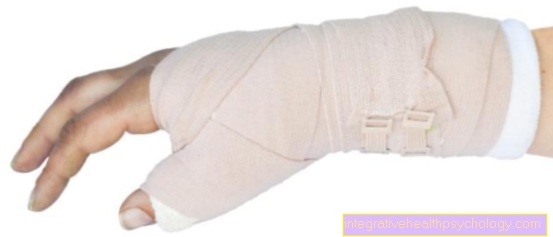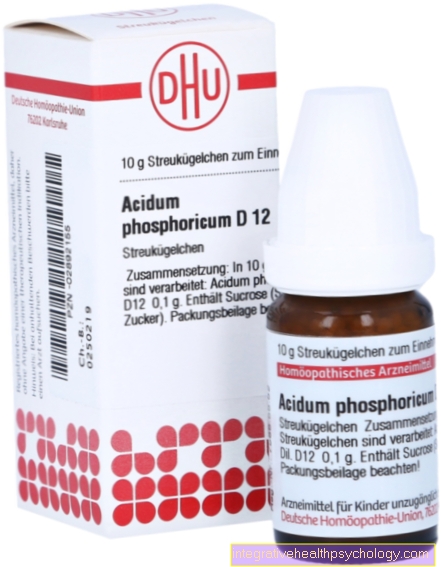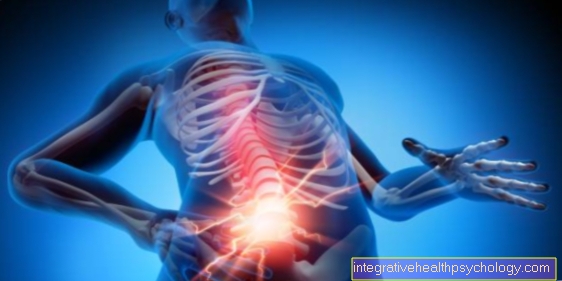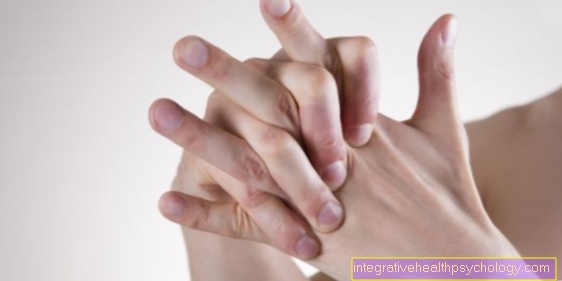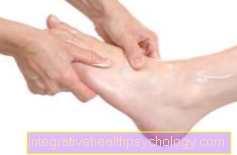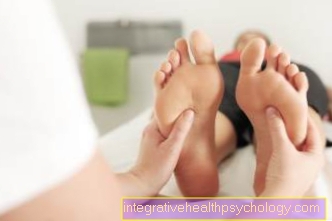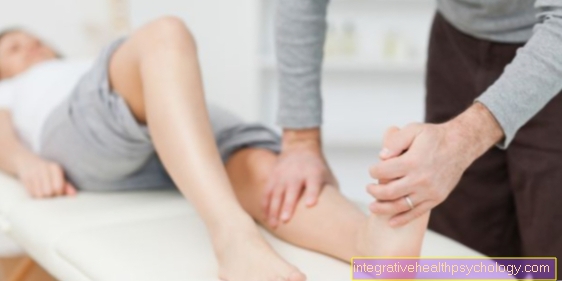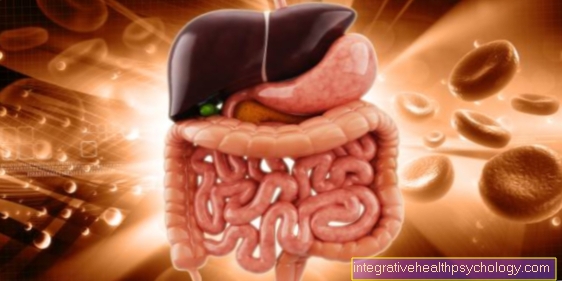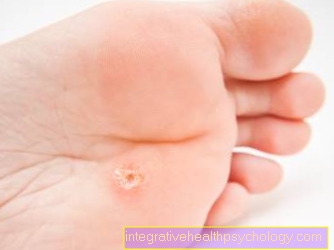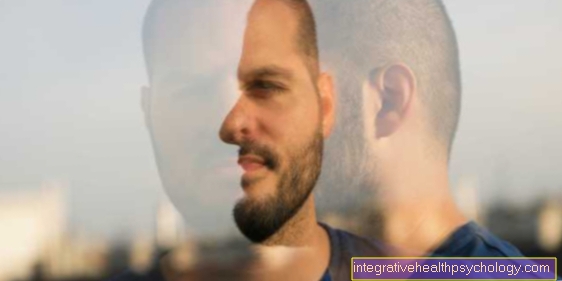Infantile cerebral palsy
Synonyms in the broadest sense
The term "infantile cerebral palsy" comes from Latin and means something like "brain paralysis", it is often abbreviated as ICP.
definition

Infantile cerebral palsy belongs to the group of movement disorders and is a disease that causes brain damage in early childhood. It usually manifests itself in disorders of the muscular and nervous system, but other systems in the brain can also be affected. For example, language, thinking or hearing can be impaired. However, the focus is more on movement disorders and not necessarily possible impaired intelligence. In the case of light shapes, the latter can even be omitted or neglected. Depending on the severity of the case, a normal school can be attended without any particular integrative focus.
MRI of the brain in infantile cerebral palsy
Magnetic resonance imaging (MRI) of the brain is part of the typical diagnostic spectrum for infantile cerebral palsy. With this form of imaging, circulatory disorders of the brain, such as bleeding or oxygen deficiency situations, can be shown. The disease can also lead to an enlargement of the cerebrospinal fluid chambers, which is clearly visible through the MRI examination.
Using special forms of magnetic resonance tomography, it is possible to differentiate between damaged and functional nerve cells, centers and nerve pathways.
However, an unequivocal diagnosis cannot be made by means of an MRI examination; it rather serves to rule out other possible causes and can substantiate the suspicion of infantile cerebral palsy.
causes
There are many different causes of infantile cerebral palsy. It is often not possible to precisely explain why the brain was damaged.
The causes include:
- Cerebral hemorrhage, come especially at Premature baby in front
- Lack of oxygen, for example during a complicated birth
- Infectious diseases the mother during the pregnancy
Read about this: Infections in pregnancy - Substance abuse during pregnancy
- poisoning from medication or carbon monoxide
- Placental malformations
- Metabolic disorders
- Traumatic brain injury
- Hereditary diseases
- Chromosomal abnormalities
- Inflammation of the meninges or the brain by bacteria or viruses
Diagnosis

First of all, every examination should be preceded by a thorough anamnesis. Your doctor will ask questions about the course of labor and pregnancy. It is important that you report what you noticed about your child. For example, can Drinking behavior, indifference and Restlessness Provide evidence of an illness.
This is followed by a physical exam of the child. It will be the annoy and Muscles tested, and the Leg, arm and trunk position respected. To make the diagnosis "infantile cerebral palsy" too blood, urine and Nerve water (Lumbar puncture) examined. In addition, a X-ray image be made that Brain waves be measured, a sample (Biopsy) of the muscle will be taken and the eyes and ears examined.
Most importantly, however, examining the brain with a MRI. In infants, one can also Ultrasonic through the Fontanel be made. The fontanel is the point on the skull that has not yet grown together in infants and thus offers a good view of the skull using ultrasound. This investigation is complete painless.
A Metabolic diagnostics and Chromosome analysis be made.
frequency
In the literature the frequency is called 0.02% to 0.2% specified.
The frequency has increased over the years. There are two different reasons for this. First, ICPs are more and more often survived and, second, the premature birth rate is increasing. The earlier a child is born, the more susceptible it is to diseases such as cerebral haemorrhage.
Life expectancy
Life expectancy depends largely on the extent and type of infantile cerebral palsy. Most children (over 90%) reach adulthood. Children with only minor disabilities usually reach a normal age and, at best, can lead a nearly normal life with only slight physical disabilities.
With very severe forms of the disease that result in severe disability, a significantly reduced life expectancy can be expected - they often die as a result of pneumonia. Children who are completely restricted in movement and have to be fed artificially usually do not reach the age of ten.
Symptoms
The brain is the control center of the body. It controls all the senses in the body and processes information. If a part of the brain is destroyed, the brain can no longer give various commands and the body can no longer carry them out.
The symptoms of infantile cerebral palsy can vary widely, ranging from severe to barely noticeable symptoms.
Among other things, this is related to the cause and location of the brain damage in infantile cerebral palsy. For example, the bigger the bleeding, the more severe the symptoms. However, even a small amount of bleeding can have serious effects if it occurs in an important location in the brain. The most common disorders of the musculoskeletal system. The affected children have difficulty controlling their muscles, cramps and increased muscle tension (spasticity) occur. A special form of this is the so-called tetraspasticity.
Often times, nothing is noticed in the newborn. When you lift up, you may initially experience poor body stiffness. This is known in medicine as "floppy infant" and can be the first indication of infantile cerebral palsy. Often, however, infantile cerebral palsy is not noticed until the little ones start to turn, crawl, or run and have difficulty doing so. This is due to the low or high muscle tone. The children have poor muscle strength and muscle control and can therefore not coordinate movement sequences well.
There are different forms of movement anomalies. These include, for example:
-
Hemiplegia: the children can only move the right or left half of the body normally; the other half is either flaccid or has too high a muscle tone
-
Diplegia: the children can move the upper half of the body well, the lower half has difficulties
-
Tetraplegia: the children can hardly move their bodies and often also have a mental disability, but can also have a normal IQ.
In the case of abnormal muscle movement, one can often observe that the child's hips and arms are turned inward and flexed, the feet are rotated in what is known as an equinus position, and the spine is crooked.
The following symptoms may also occur:
- Muscle tremors
- epilepsy
- Speech disorders
- Mental retardation
- Grimacing
- Hearing impairment
- Squint
- Short stature
So everything is noticeable that does not take place in the context of normal early childhood development.
Just like the limitations in mobility, there can also be problems with intelligence. However, this is by no means mandatory and affected children can grow up without any mental or cognitive deficits if the corresponding areas in the brain are not damaged. In this case, the same level of intelligence can be achieved as with non-sick peers. Due to the breadth of causes and the variability of the affected areas of the brain, the severity and thus the symptoms can vary greatly.
therapy
There are conservative and operative therapies for infantile cerebral palsy. However, there is no cure for this condition; symptoms can only be alleviated.
Conservative therapies include:
-
Physiotherapy: Through daily exercises, cramped muscles can be loosened and muscle movement improved.
-
Occupational therapy: everyday activities are practiced.
-
Medication: The ICP comes with sedatives (Psychotropic drugs) and antispasmodics are used.
-
Eating and speech therapy
-
Orthopedic treatment: There are special splints and walking aids for children with noticeable foot or leg anomalies.
Before considering an operative measure, all conservative measures should be tried out, because every operation carries risks.
The operational measures include:
-
Surgery on bones: Here already bent bones are operated on by breaking them and bringing them into a normal position
-
Operation on tendons: Tendons, such as the Achilles tendon, are lengthened to reduce the tension in the muscle. Muscles can also be relocated to reduce tension
-
Surgery on nerves or muscles that are constantly under tension can cause great pain. If conservative treatment is unsuccessful, the nerves to the muscle can be cut. Then the muscle becomes slack, the pain gets better, but the muscle is no longer able to move.
-
Surgery on joints: If the joints are very unstable, they can be stiffened.
-
Installation of a drug pump: This involves installing a pump with drugs near the spinal cord. The drugs have an inhibitory effect on the spinal cord, thus reducing the tension in the muscle, as the signals from the brain can no longer pass through the spinal cord to the muscle.
Infantile cerebral palsy is one of the diseases for which there is currently no cure. The symptom-relieving therapy can, however, restore a large part of the quality of life, depending on the severity of the disease.
Read more about this: What possibilities are there to solve a spasticity?
physical therapy
Physiotherapeutic treatment of the patient is essential. Above all, the methods according to Bobath and Vojta are used, which are intended to make normal movement sequences accessible again for those affected.
With the Bobath treatment method, an individual treatment concept is developed for each patient, with which normal movement patterns are to be promoted and incorrect movement patterns are to be suppressed. The background to the therapy is the assumption that the brain can be remodeled through repetitive activities so that healthy brain regions can take over the function of diseased regions.
In Vojta therapy, the therapist sets mechanical stimuli in a targeted manner, which should lead to the triggering of a movement complex. This should make movement sequences accessible again, which in principle occur automatically / reflexively in healthy people. For example, those affected may be able to sit up again.
It is important to include the parents or other contact persons in the physiotherapeutic treatment approaches, so that the therapy does not only take place in the therapy session of the physiotherapist, but is applied daily throughout the day.
Occupational therapy
Occupational therapy is primarily used to learn about activities that are relevant to everyday life and enable those affected to promote their independence and participate more in life. The quality of life should be increased through the treatment.
The applications of occupational therapy include, for example, the use of special writing aids or other auxiliary techniques that support everyday life, because the motor skills of the hands are often massively impaired in patients with infantile cerebral palsy.
Speech therapy
Speech therapy is required in most cases. Usually, those affected have language restrictions, as the muscles that are responsible for the production of language are also affected by the disease. Sick people are then often difficult to understand without having an intellectual disability.
Speech production can be improved through speech therapy and communication with the environment can be made easier.
In addition, speech therapy promotes food intake, since the disease is usually associated with swallowing difficulties.
course
The course depends largely on the form and severity as well as the time of diagnosis and therapy of infantile cerebral palsy. The earlier the disease is treated, the sooner the functions of damaged nerve cells can be taken over by other healthy brain cells.
More than 90 percent of the children affected reach adulthood with the disease. Most people can go to a normal school.
The development of the musculoskeletal system is often restricted and makes the use of crutches or the like. required. The faster new movements can be learned, the better the prognosis seems to be.


